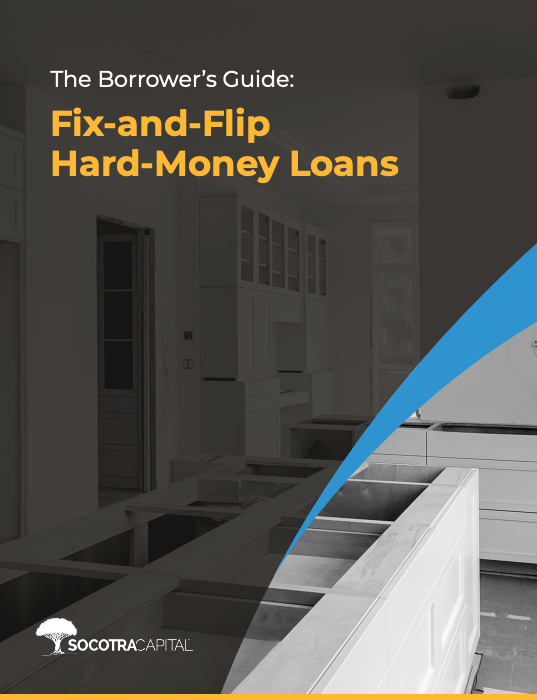The Borrower’s Guide:
Fix-and-Flip Hard Money Loans

Introduction
Enterprising investors know that with a good eye for opportunity, enough cash, and a little elbow grease, the right property can generate quick profits or long-term passive income. Flipping—which is essentially purchasing a property, improving it, and selling it for a profit—is not a new trend, but it has been on the rise in recent years.
In 2019, Americans flipped 245,864 single-family homes and condos, bringing flipping to its highest level since 2006. Financing was also up 21 percent from 2018, with $32.5 billion going to borrowers for real estate flips. There’s a reason this investment activity has gained in popularity over the years—it can be quite lucrative. The median gross profit from flipping in 2019 was $62,900, which represented about a 41 percent return on investment. Even when you account for the costs that go into renovating, when done right, flipping can generate a large return in a fairly short period of time. Although these figures represent residential flipping, which includes single-family homes and condominium units, it’s also possible to flip commercial properties such as apartment complexes and other commercial spaces like office, retail, industrial, and mixed-use buildings.
This guide is designed to introduce the basic concepts of fix-and-flip loans for both residential and commercial properties, and to help you determine if this type of loan is right for you.
Download a PDF version of this guide by filling out this form, or keep scrolling to learn more.


Chapter 1
What Is a Fix-and-Flip Loan?
A fix-and-flip loan is a short-term loan that is intended to help you both buy and rehab a property and then sell it at a higher value, at which point you pay off the loan and keep the remainder as your profit. The typical time frame for this type of loan is 6-9 months, but terms can extend up to 36 months in some cases if the rehab scope is material.
Lenders determine whether you qualify for a fix-and-flip loan based on the equity you have in other properties. Eligibility is not based on your personal financial history or your credit score, so even if you can’t get a loan from a traditional bank, you may be able to get a fix-and-flip loan from a hard money lender. The amount of the loan is based on the expected value of the property after repairs have been made and the expected rehab costs to make those repairs. Depending on the lender, you may be able to borrow enough cash to purchase a distressed property and cover up to 85 percent of the rehab costs.
One of the greatest benefits of a fix-and-flip loan from a hard money lender is that fast approval times—in a matter of days and not weeks— allow you to move quickly. This gives you an advantage over other buyers because you and the seller don’t have to wait for a long approval and closing process, allowing you to compete with all cash offers. This is especially important if you are investing in an area with a lot of flipping competition.
Eligibility is not based on your personal financial history or your credit score.
Resources

Chapter 2
What Scenarios Call for a Fix-and-Flip Solution?
The primary goals for a fix-and-flip investment are to:
- Minimize renovation expenses
- Maximize the market value of the property
- Sell the property as quickly as possible
The right purchase price
When looking for suitable properties, keep the 70 percent rule in mind. This rule says that to determine how much you should pay for a property, you should multiply the after-repair value (ARV) by 70 percent and subtract the repair costs. For example, if you expect the repair costs to be $20,000 and the ARV to be $200,000, you shouldn’t pay more than $120,000 for the home:
(ARV x 70%) - repair costs = purchase price
($200,000 x 70%) - $20,000 = $120,000
If your estimates for the repair costs are accurate and you’re able to sell the improved home for $200,000, you’ll make a gross profit of $80,000 and a net profit of $60,000, which is a pretty good return for a few months of work. Of course, this is a simple example, and there are more variables involved in reality, but the 70 percent rule is a good guideline to use when deciding whether or not to purchase a property. If you are a real estate agent or a contractor, you may be able to flex this ratio.
The 70% rule says that to determine how much you should pay for a property, you should multiply the after-repair value (ARV) by 70 percent and subtract the repair costs.
The right property
For a residential fix and flip, look for neighborhoods with a strong market outlook, a trend of increasing prices, and volume that indicates buyers are coming to the area. There are many online tools to help with identifying these, some of which are free and some of which are paid. Once you have identified potential neighborhoods, look for motivated sellers who might be willing to sell their property at a lower price in exchange for a quick transaction. These might be owners of distressed properties, short sales, foreclosures, or real estate- or bank-owned properties.
When evaluating potential properties, avoid those with structural issues and focus on improving the features that are cost-effective and drive value. These might include new appliances, counters, cabinets, and flooring. Other cosmetic improvements, such as landscaping and fresh paint, can also go a long way toward increasing the value of a property with a relatively modest investment.
When evaluating potential properties, avoid those with structural issues, and focus on improving the features that are cost effective and drive value.
For a commercial flip, suitable properties might include apartment complexes that will improve with renovations or retail properties in areas that are starting to boom. If you can identify a neighborhood with a limited inventory but a growing demand for viable commercial spaces, you would be wise to scoop up properties that you can improve, lease, and sell at a profit. You might also find that following the latest trends can help you identify potential commercial investment properties. For example, a plaza with a former department store might present the perfect opportunity for a popular grocery chain or fitness studio. Other common commercial flip scenarios include:
- Purchase land, do the permitting and site work to make it buildable, and then sell ready-to-build lots to a builder
- Purchase property, entitle it for a larger development and then sell it to a builder
- Purchase a vacant building, add some tenant improvements, secure long-term tenants, and then sell the building
Like with a residential fix and flip, look for properties that are structurally sound but could be improved with cosmetic updates. Location is also critical for commercial spaces. Properties that have ample parking and are near major roads or have access to mass transit are likely to be more appealing to potential buyers or renters.
A commercial fix and flip is based on the same concepts as residential flipping—the goal is to buy low, minimize expenses, and increase the value as much as possible. However, although the “fix” part of the equation might be similar, the “flip” typically takes longer, so you should take this route only if you can tolerate a longer sales cycle. Because of this, a commercial flip actually uses a different type of financing, called a bridge loan. For this type of loan, the terms are longer, and the intent is to improve a vacant space to attract tenants and convert it into a bankable property.
Properties that have ample parking and are near major roads or have access to mass transit are likely to be more appealing to potential buyers or renters.

Chapter 3
Weighing the Pros and Cons of Fix-and-Flip Loans
Like any type of investment, a fix-and-flip loan comes with pros and cons. In addition to being aware of the various challenges you might face—unexpected issues with the property, higher repair costs, project delays, and a lower sale price—it’s a good idea to understand all aspects of your loan.
Pros of fix-and-flip loans
Fix-and-flip loans from hard money lenders close faster than traditional bank loans, which could give you an edge over the competition. Some buyers might also be willing to sell at a lower price if the transaction can happen faster, and a hard money loan allows you to offer this.
Unlike longer-term real estate investments, a fix and flip offers the potential of a high ROI with quick returns. With no prepay penalties, you can sell the property as fast as you want to and move on to the next one. There is also no limit on the number of properties for which you can get this type of financing. As long as you have the equity to back it and the resources to do the work, you can flip multiple properties at the same time.
Fix-and-flip loans cover up to 85 percent of the total project cost, which is the purchase price plus the cost of the rehab, so even if you don’t have much cash on hand or a great credit score, this type of real estate investment is available to you.
Cons of fix-and-flip loans
Fix-and-flip financing does come with slightly higher interest rates, but as long as you are able to flip the property within the terms of the loan, it’s a reasonable cost of doing business.
It’s also important to know that the loan proceeds can be used only for purchasing and renovating the property. Funds are released throughout the course of the project, so you must make progress to continue gaining access to the cash.
It’s also important to know that the loan proceeds can be used only for purchasing and renovating the property.
Resources

Why Real Estate Investors and Developers Upgrade to Copper Pipes in Fix-and-Flip and Fix-to-Rent Projects
Read More
Chapter 4
Top 13 Questions You Should Ask When Getting a Fix-and-Flip Loan
Every lender is different, so before you sign on the dotted line for your fix-and-flip loan, ask these key questions.
1. What are the points and interest rates?
All fix-and-flip loans come with interest rates, but they vary depending on the lender. Factor in the cost of interest when calculating your total project cost to make sure you can meet your ROI goals. Most hard money lenders charge points on their loans, so make sure you know what those costs are.
2. What are the loan terms?
Loan terms are a major factor in determining the monthly payments and overall cost for a fix-and-flip loan. Make sure your loan terms allow enough time to complete the work. It’s also worth asking if you have the option to convert it into a rental loan once the rehab is complete.
3. Is the loan based on the ARV or current value?
Unlike traditional mortgages, which are based on the current value of the property, fix-and-flip loans are typically based on the ARV. This is good for borrowers because it means they can get more cash for the rehab project. However, remember that some form of down payment is typically required.
4. Is an appraisal required?
Most lenders will require an appraisal before closing a fix-andflip loan, and many will request both the current value and the estimated ARV. Although there is a cost for this part of the process, it can actually save borrowers money in the long run if the appraiser finds something that makes the flip unwise.
5. Are there any up-front fees?
Some lenders have closing fees or other costs associated with the loan. Ask what they are and factor them into your overall project cost.
6. How much is required for the down payment?
Although a fix-and-flip loan is backed by your equity in other properties, lenders still expect you to have some skin in the game. Ask what percentage they expect for a down payment and whether it’s based on the purchase price or the total loan amount. Most hard money lenders ask for a down payment in the range of 10-25 percent
7. Are there any penalty fees?
If you aren’t able to flip the property fast enough or if other unexpected financial challenges arise, it’s a good idea to know what potential penalties are associated with extensions.
8. When and how are the funds for the rehab disbursed?
With a fix-and-flip loan, you don’t get all of the money up front. Ask your lender about their process for disbursing funds so you know it will go smoothly once you have started the project. Rehab funds are usually disbursed in draws as work is completed. This means that you will need some cash to get started.
9. How long does it typically take for the loan to close?
When making offers on distressed properties, it helps to know your closing time so that you can set realistic expectations with sellers. Fix-and-flip loans usually move much more quickly than bank financing. Some hard money lenders are able to close in as few as 48 hours, but the typical timeline is more like one or two weeks
10. Do I have enough funds to complete the project?
A fix-and-flip loan covers a percentage of your total project cost (including the cost to purchase the property together with the rehab project costs). If you don’t have enough money to cover the difference, you might not be ready for a fix and flip, or you might need to bring in a partner
11. What if I decide to fix and hold?
Many real estate investors follow the BRRRR model—buy, rehab, rent, refinance, repeat. If you purchase with the intent of fixing and flipping but then decide that passive rental income is the way to go, you can refinance it to pay off the loan and get a more traditional mortgage. You might also decide to fix and hold if the market shifts while you’re doing the rehab work and you can’t get a high enough selling price to meet your profit goals.
12. What are the risks of fixing and flipping?
Fixing and flipping is not for everybody, and it’s important to understand that some work is required. Some of the risks include overestimating the after-repair value, underestimating the amount of time and money required for the flip, encountering unforeseen damage that costs more than expected, and running into material or labor shortages that cause project delays.
13. Can additional collateral be used to help finance the loan?
If you don’t have enough down payment for the purchase, ask your lender if they accept other properties to be used as additional collateral.
Socotra Capital Is Here to Help
Whether you’re an experienced flipper or just getting started in real estate investing, Socotra Capital is here to provide the funds you need. When you spot an opportunity, we know you need to act fast, which is why we offer quick preapproval, speedy appraisals, and short closing times. A feature unique to Socotra Capital is that we have our appraisers review the values before every loan offer so you can rest assured that there will be no surprises and that your project will be successful.
Flipping homes is a hot trend for a reason.
If you want to make money by rehabbing properties, go to our fix-and-flip page to get in touch.
Forward this on to a friend
Know someone who might be interested in what you just learned? Fill out the form below to get a copy you can share.





.jpg?width=2000&name=GettyImages-498714064%20(1).jpg)






